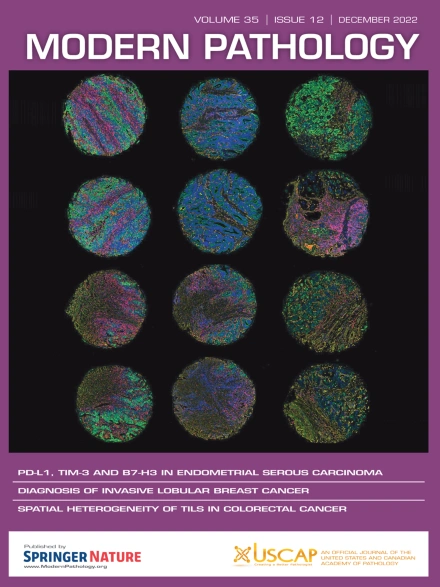Polychromatic Polarization Microscopy Differentiates Collagen Fiber Signatures in Benign Pancreatic Tissue and Pancreatic Ductal Adenocarcinoma
IF 7.1
1区 医学
Q1 PATHOLOGY
引用次数: 0
Abstract
The orientation of collagen fibers in relation to malignant epithelium is known to carry prognostic information in a variety of tissues. The data are the strongest for breast and pancreatic ductal adenocarcinoma. However, information inherent in collagen fiber topology in malignant tissues remains untapped in daily surgical pathology practice, largely because collagen fibers within areas of desmoplasia cannot be resolved with standard diagnostic microscopy. The methodologies used to visualize collagen fiber orientation are either of insufficient resolution to consistently capture collagen fiber topology or require resources in time and money that do not fit into the daily surgical pathology workflow. Polychromatic polarization microscopy has the potential to bring collagen topology to the attention of pathologists during their routine work. It has been demonstrated to be equivalent to the gold standard methodology used to research collagen, second harmonic generation. We use polychromatic polarization microscopy to visualize and describe the differences in collagen topology in normal pancreas, chronic pancreatitis, and pancreatic ductal adenocarcinoma with a standard microscope, using hematoxylin and eosin-stained sections. In the process, we propose a lexicon with which to describe the morphologic characteristics of collagen in benign and malignant pancreatic tissues.
多色偏振显微镜鉴别良性胰腺组织和胰腺导管腺癌的胶原纤维特征
胶原纤维的方向与恶性上皮有关,在多种组织中携带预后信息。这一数据在乳腺和胰腺导管腺癌中最为明显。然而,在日常外科病理实践中,恶性组织中胶原纤维拓扑结构的固有信息仍未得到开发,这主要是因为在结缔组织形成区域内的胶原纤维无法通过标准诊断显微镜来解决。用于可视化胶原纤维方向的方法要么分辨率不足,无法始终如一地捕获胶原纤维拓扑结构,要么需要时间和金钱上的资源,不适合日常外科病理工作流程。多色偏振显微镜有可能在病理学家的日常工作中引起胶原结构的注意。它已被证明相当于用于研究胶原蛋白的金标准方法,二次谐波产生。我们使用多色偏振显微镜在标准显微镜下观察和描述正常胰腺、慢性胰腺炎和胰腺导管腺癌中胶原拓扑结构的差异,使用苏木精和伊红染色切片。在这个过程中,我们提出了一个词汇来描述良性和恶性胰腺组织中胶原蛋白的形态特征。
本文章由计算机程序翻译,如有差异,请以英文原文为准。
求助全文
约1分钟内获得全文
求助全文
来源期刊

Modern Pathology
医学-病理学
CiteScore
14.30
自引率
2.70%
发文量
174
审稿时长
18 days
期刊介绍:
Modern Pathology, an international journal under the ownership of The United States & Canadian Academy of Pathology (USCAP), serves as an authoritative platform for publishing top-tier clinical and translational research studies in pathology.
Original manuscripts are the primary focus of Modern Pathology, complemented by impactful editorials, reviews, and practice guidelines covering all facets of precision diagnostics in human pathology. The journal's scope includes advancements in molecular diagnostics and genomic classifications of diseases, breakthroughs in immune-oncology, computational science, applied bioinformatics, and digital pathology.
 求助内容:
求助内容: 应助结果提醒方式:
应助结果提醒方式:


